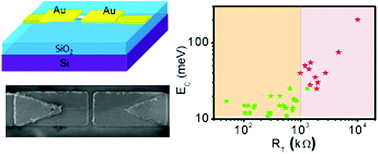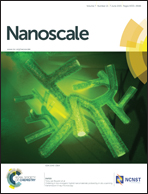Towards parallel fabrication of single electron transistors using carbon nanotubes†
Abstract
Single electron transistors (SETs) are considered to be promising building blocks for post CMOS era electronic devices, however, a major bottleneck for practical realization of SET based devices is a lack of a parallel fabrication approach. Here, we have demonstrated a technique for the scalable fabrication of SETs using single-walled carbon nanotubes (SWNTs). The approach is based on the integration of solution processed individual SWNTs via dielectrophoresis (DEP) at the selected position of the circuit with a 100 nm channel length, where the metal–SWNT Schottky contact works as a tunnel barrier. Measurements carried out at a low temperature (4.2 K) show that the majority of the devices with a contact resistance (RT) > 100 kΩ display SET behavior. For the devices with 100 kΩ < RT < 1 MΩ, periodic, well-defined Coulomb diamonds with a charging energy of ∼14 meV, corresponding to the transport through a single quantum dot (QD) was observed. For devices with high RT (>1 MΩ) multiple QD behavior was observed. From the transport study of 50 SWNT devices, a total of 38 devices show SET behavior giving a yield of 76%. The results presented here are a significant step forward for the practical realization of SET based devices.


 Please wait while we load your content...
Please wait while we load your content...